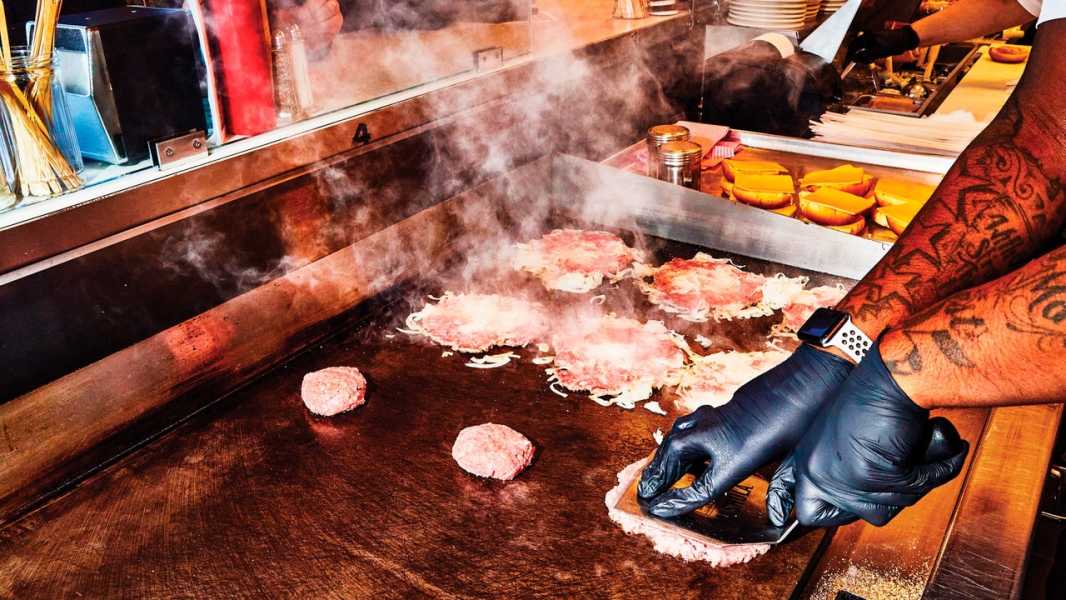
Save this storySave this storySave this storySave this storyYou’re reading the Food Scene newsletter, Helen Rosner’s guide to what, where, and how to eat. Sign up to receive it in your in-box.
As with pizza, barbecue, and other archetypal American foods, there’s no shortage of strong opinions about what constitutes a proper burger, but George Motz has earned a right to his opinion more than most. Arguably our foremost scholar of hamburgers and their history, Motz has made documentaries, hosted television shows, and authored several books about burgers, and has even taught a hamburger seminar at N.Y.U. So when he announced, last year, that he would be opening a burger joint of his own, New York’s center of hamburger gravity shifted—subtly, but perceptibly—toward the red brick building on the corner of MacDougal and Houston where Motz had signed a lease. The restaurant, which opened in November, all kitted out with chrome and Formica, is a retro fantasia bearing the same grand, unifying, hand-on-heart name as his first film, and his first book: Hamburger America.
Hamburger America
51 MacDougal St.
(Burgers and sandwiches $5-$11.50.)
“Like a haiku, the best burgers benefit from an imposed limitation of form,” he wrote in his “Great American Burger Book.” Motz believes in beefiness as a hamburger’s foundational attribute, something to which all other elements—the bun; a sauce, perhaps; a considered minimality of toppings—ought to work in dedicated service. There are just two burgers on the menu at Hamburger America. The Classic Smash, in which a baseball of freshly ground beef is smeared into lace-edged flatness on a searing hot flat-top griddle, can be ordered with melty American cheese or “all the way,” with diced onion, a few dill pickle rounds, and a slash of mustard. The signature George Motz’s Fried Onion Burger uses an Oklahoma technique of covering the beef with a heap of sweet onions sliced paper-thin, and smashing the onion-topped meat into the griddle. After the burger is flipped, the onions caramelize and char between the meat and the griddle, all but disappearing, while giving the patty a haunting sweetness. It’s served with no condiments, no dressings—just a slice of American cheese, as both lubrication and salt, and two salutatory pickle rounds on the side.
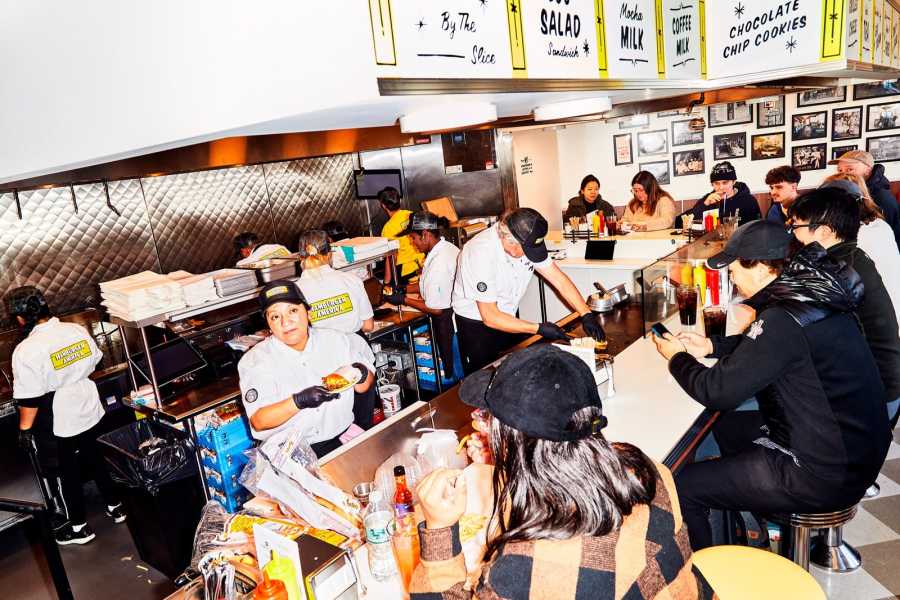
The best seats in the house are at the L-shaped counter—especially the stools right in front of the burger station.
The burgers, an impressively affordable $7.25 apiece, are on the smaller side—a hungry diner could easily down two or three before pausing for breath. They are also available with double patties ($11.50), though it seems foolish to disturb the single patty’s perfect ratio of bread to meat. Despite all the fanfare, I found the onion burger a little bland—a few shakes of hot sauce liven it up, though doctoring it at all feels a bit sacrilegious. But the Classic Smash is fantastic, strong and correct. You don’t need to know the history of burgers to be taken with its honest flavors, its modest size, its firm handshake of pickle and onion and good ol’ American ground beef. It’s a hamburger you trust, a hamburger you’d feel good about taking your daughter to prom.
In addition to the two hamburgers, there are fries, of course (thin and crisp, but oversalted on one visit and not quite salty enough on another), plus a handful of simple, school-lunch-ish sandwiches, including tuna salad made with sweet pickle relish, and a deeply satisfying peanut-butter-and-jelly. There’s an unfussy grilled cheese (American, on buttered bread), and a secret, off-menu sandwich that I’ve seen described elsewhere, inaccurately, as a patty melt. In fact, it’s a grilled cheese with a smash-burger patty inside it, and it’s singularly terrific. There’s a milk menu, your choice of plain or chocolate or coffee (a Rhode Island specialty, made with Autocrat-brand coffee syrup, sweet and bitter); the latter two can be topped with a squirt of seltzer to make a very decent egg cream. The best seats in the house are at the L-shaped counter—especially the stools right in front of the burger station, where Motz himself is likely to be captaining the griddle. He’s tall and muttonchopped, with a medusa-like shock of silver hair. A cartoon version of his grinning face is the restaurant’s logo, silk-screened onto the breast of yellow T-shirts, sewn as a patch on the sleeves of crisp white chefs’ shirts, and laser-etched onto the blade of Motz’s own “Smashula,” a custom tool he wields theatrically to flatten and flip each patty.
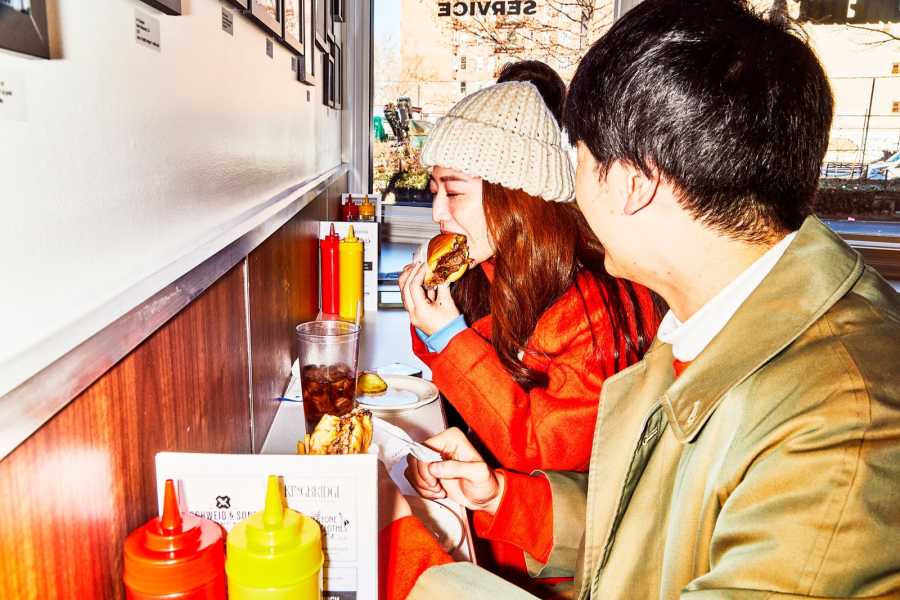
The Classic Smash can be ordered with American cheese or “all the way.”
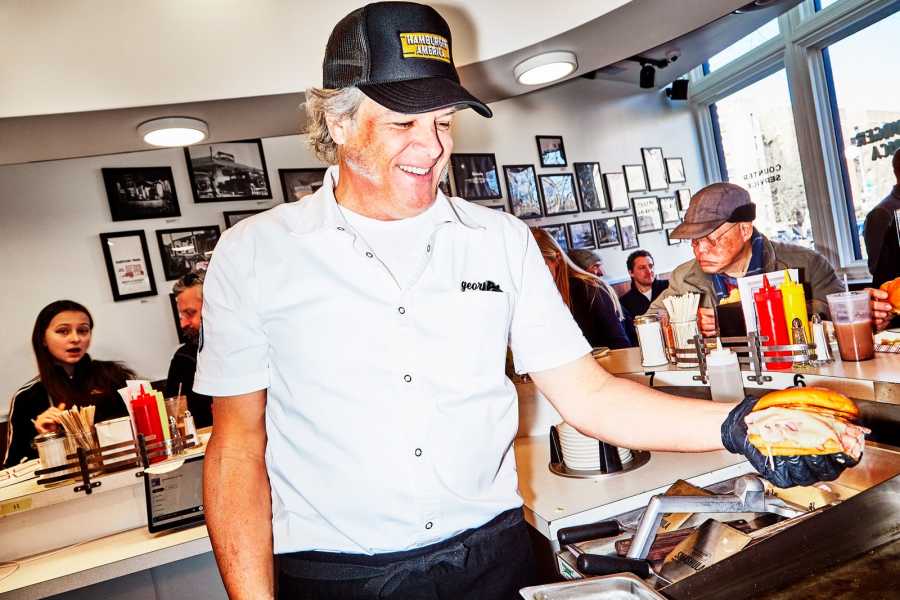
George Motz, the owner of Hamburger America, holds a hot ham sandwich, the menu’s sleeper hit.
On one of my visits to Hamburger America, no fewer than three employees mentioned, unprompted, that the hot ham sandwich was the sleeper hit of the whole menu. They did not lie. I watched as Motz piled a tidy mountain of meat, freshly thin-sliced, onto the flattop, draping two slices of lacy Swiss cheese overtop. He left the whole thing to warm under a metal cloche until it was melty and rich, then transferred it to a butter-toasted burger bun. As Motz wrapped the finished sandwich in parchment paper and slid the plate to me across the counter, he asked if I was from the Midwest. I said that I was from Chicago, and he shook his head. “Almost! It’s a real Milwaukee thing, this sandwich,” he said, before turning his focus back to the whack-a-mole of the griddle, full of patties in various stages of historically accurate smash. Looking it up later, I learned that hot ham and rolls has, for generations, been a Sunday tradition in southeast Wisconsin, when families line up at their favorite bakeries for an easy, affordable post-church meal.
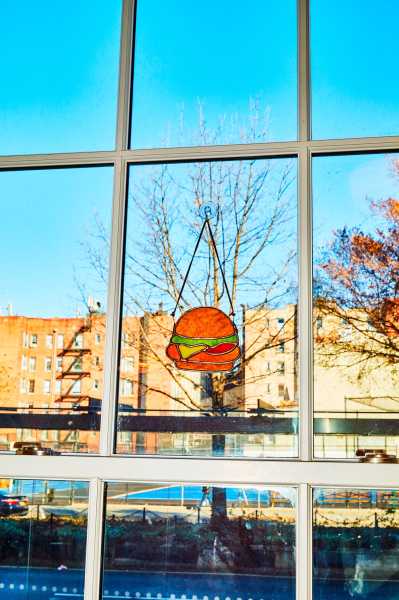
A stained-glass cheeseburger hangs in the window, catching the sun over Houston Street.
The servers sold the pies hard, too: “It’s the best Key-lime pie you’ve ever had,” one said as she hovered around the perimeter of the counter, taking orders and clearing empty plates. (A seating area in the back, with proper tables and yellow-upholstered booths, is self-serve, with ordering done at a fast-food-style register kiosk in the center of the restaurant.) But I saw few slices of pie in front of my fellow-diners, and even fewer hot ham sandwiches. Smash burgers are having a moment right now, having been dragged into the spotlight by the riptides of social media. With Hamburger America, however, Motz aims to engage with history, not with trend-seekers. “This is the way burgers were made in America at the very beginning. The progenitor of every burger we have ever seen, made, or tasted,” he writes in “The Great American Burger Book.”
Helen, Help Me!
E-mail your questions about dining, eating, and anything food-related, and Helen may respond in a future newsletter.
Motz is interested in the hamburger as an object and a foodstuff, but he’s just as invested in the restaurants that serve them, especially the counter joints and luncheonettes where burgers are the star of the show. His “Hamburger America” book and documentary are about places and people: family-owned businesses, recipes and techniques that span generations. With its throwback fixtures and hand-painted signage, the restaurant is obviously designed to feel like the sort of place that belongs in a Motzian chronicle. The walls are crowded with ephemera: old menus, newspaper ads, photographs of clapboard drive-ins and mid-century neon signs, a few souvenirs from Motz’s own résumé of burger residencies and pop-ups. Over the booths in the back of the restaurant hang three especially large photos, shot by Motz himself. One, depicting the interior of Edina, Minnesota’s Convention Grill (opened in 1934), is a near-perfect echo of Hamburger America’s own counter. Motz’s restaurant may be a pastiche as much as it’s a temple, a meticulous facsimile of the time-worn and the beloved, but at least he’s not stingy with the credit. ♦
Sourse: newyorker.com